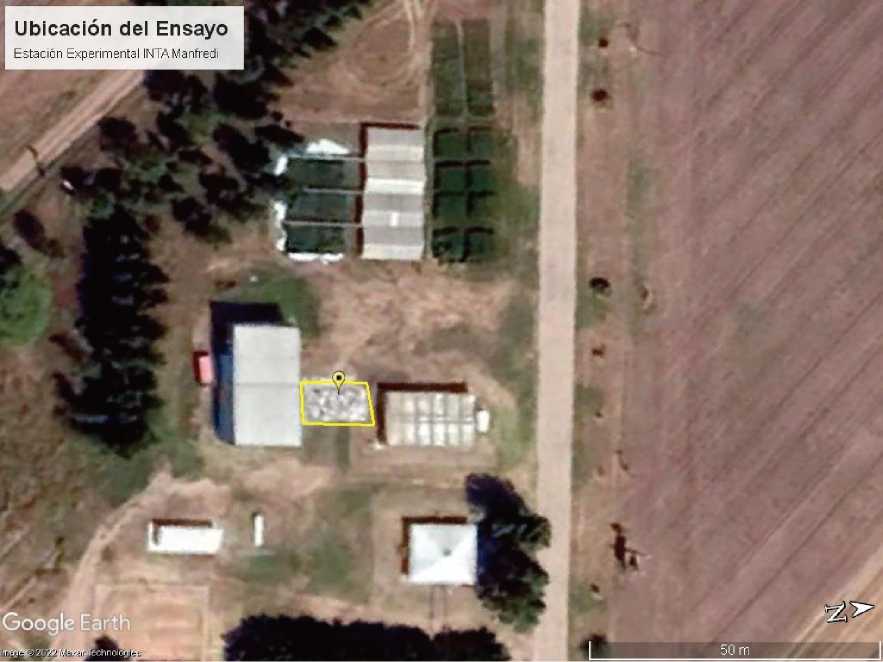
10.31047/1668.298x.v1.n40.40311
COMUNICACIÓN
Effects of solarization on the biological and chemical properties of a substrate
i. Ayoub
E. D. Bigatton
D. Ortiz
M. V. Archilla
E. i. Lucini
C. Vázquez
M. V. Moreno
1 Ayoub, I. (ORCID: 0000-0001-8286-108X), Bigatton, E. (ORCID: 0000-0002-7896-5369), Archilla, M. (ORCID: 0000-0002-2055-4049), Lucini,E. I. (ORCID: 0000-0003-0385-3271) y Vázquez, C. (ORCID: 0000-0002-8044-8942): Universidad Nacional de Córdoba, Facultad de Ciencias Agropecuarias, Cátedra de Microbiología Agrícola, Córdoba,Argentina. Moreno, V. (ORCID: 0000-0002-9699-0349) y Or-tiz, D. (ORCID: 0000-0001-8584-8921): Estación Experimental INTA Manfredi, Córdoba, Argentina. Correspondencia a: iayoub@unc.edu.ar
ABSTRACT
Greenhouse experiments and productions require a high-level control of pests and diseases. Nowadays, society demands to find sustainable alternatives to replace agrochemicals in food production. Solarization is one of the most promising tools due to its low installation cost and control efflciency. The objective of this study was to evaluate the effect of solarization on a substrate for a greenhouse experiment in Córdoba, Argentina. At the INTA-Manfredi Agricultural Experimental Station, 12 m3 of substrate underwent the solarization process, being exposed to solar radiation for six months (December 2021-May 2022). In addition, substrate control remained in natural conditions. Soil functional groups using different growth culture media were measured to verify the solarization effect. The solarized substrate showed a reduction in proteolytic microorganisms (90 %), mesophiles (93 %) and fungi (100 %). The ammonifiers and biological nitrogen fixers microorganisms were reduced by 78 % compared to the control treatment, while yeasts and Bacillus spp. showed reductions up to 64 % and 69 %, respectively. Solarization achieved a 99 % reduction of weeds. The pH decreased by 1.9 % and the electrical conductivity (EC) increased by 5.91 % in the solarized substrate. The total dissolved solids increased by 169 % for the solarized substrate.
Key words: functional groups, microbiota, weeds, disinfection.
RESUMEN
Los ensayos y la producción en invernaderos requieren un alto nivel de control de plagas y enfermedades. La sociedad exige alternativas sostenibles que sustituyan a los agroquímicos. La solarización es una de las herramientas prometedoras debido a su bajo costo y eficiencia de control, para la desinfección de sustratos. El objetivo de este estudio fue evaluar el efecto de la solarización sobre un sustrato en Córdoba, Argentina. En la Estación Experimental Agropecuaria INTA-Manfredi, 12 m3 de sustrato se expusieron a la radiación solar durante seis meses (diciembre 2021 - mayo 2022). El sustrato control no fue solarizado. Se midieron grupos funcionales utilizando diferentes medios de cultivo. El sustrato solarizado mostró una reducción de microorganismos proteolíticos (90 %), mesófilos (93 %) y hongos (100 %). Los microorganismos amonificadores y fijadores biológicos de nitrógeno se redujeron en un 78 % en comparación con el tratamiento de control, mientras que las levaduras y Bacillus spp. mostraron reducciones de hasta el 64 % y el 69 %, respectivamente. Las malezas se redujeron 99 %. El pH disminuyó un 1,9 % y la conductividad eléctrica (CE) aumentó un 5,91 % en el sustrato solarizado. Los sólidos disueltos totales (SDT) aumentaron un 169 %.
Palabras clave: grupos funcionales, microbiota, malezas, desinfección.
INTRODUCTION
The demand for environmentally friendly food production processes has increased in recent years. Greenhouse productions commonly use highly toxic agrochemicals for soil disinfection. Methyl bromide is one of the most widely used agrochemicals in horticulture production and is an agent that damages the ozone layer (Bernal, 2008). The bromine atoms released into the atmosphere react with ozone to form chlorine or bromine monoxide (Vuelta Lorenzo, 2014). It is a challenge to control crop pests and diseases without using agrochemicals.
An alternative to soil chemical treatment is solarization, which is a process of hydrothermal disinfection of the soil. To achieve high disinfection values, the soil or substrate must be moistened, covered with a transparent polyethylene sheet and exposed to solar radiation during the hottest months.
Soil is a complex ecosystem made of mineral, organic and biological compounds. Likewise, it has a diverse community of microorganisms, some of which are beneficial and other pathogens.
According to their growth temperature, the bulk of these microorganisms is mesophile (with optimum growth temperature between 30 and 40 °C). However, temperatures above 45 °C or higher during a period of time are lethal for these types of microorganisms (Arboleya et al., 2008).
For an effective solarization process, the temperature inside the solarization soil profile or substrate must reach 40 °C-55 °C for more than five hours during the day (Bettiol et al., 2014; Jiménez Rodríguez, 2019; Marín-Guirao et al., 2019; Al-Shammary et al., 2020). Solarization efficacy depends on the soil or substrate depth, moisture content and surrounding air temperature below the polyethylene sheet (D'Addabbo et al., 2010). Moisture content is crucial because it increases thermal conductivity and heat transfer affecting solarization efficiency (Al-Shammary et al., 2020).
Solarization reduces pest, pathogens and weeds pressure (Parra et al., 2015) and improves physical and chemical properties of soil and nutrient availability (Wang et al., 2016; Jiménez Rodríguez, 2019; Marín-Guirao et al., 2019 and Al-Shammary et al., 2020). Organic matter, nitrogen (NH4+, NO3-) and some macronutrients and micronutrients (K, Mg, Ca, Na) ¡ncrease after solarization, All these changes ¡mprove agricultural productivity (Simmons et al,, 2016), In addition, solarization has been documented to ¡ncrease the water holding capacity of soils (Al-Shammary et al,, 2017),
Greenhouse production was affected by Verticillium spp., Sclerotium spp., Fusarium spp,, Aspergillus spp, and Alternaría spp, Soil solarization practices could reduce their impact because they are heat-sensitive microorganisms (Katan et al,, 1989 and Marín-Guirao et al,, 2019), Solarization also eliminates bacteria or reduces its abundance and diversity. In contrast with chemical disinfection that produces a biological vacuum, solarization allows some saprophytic organisms to survive and colonize the soil avoiding a re-¡nfestat¡on with unwanted organisms (Jiménez Rodríguez, 2019), The objective of this work was to evalúate the effect of solarization on a substrate for a greenhouse experiment in Córdoba, Argentina.
MATERIALS AND METHODS
Plot location
The solarization process was conducted from December 2021 to May 2022 at the Agricultural Experimental Station (AES) INTA Manfredi (latitude 31° 51' 31,99” S, longitude 63° 44' 29,20” W) (Figure 1), Daily temperature and solar radiation were obtained from the meteorological station located at the INTA Manfredi AES.
Coverage materials
The substrate was covered using two different polyethylene sheets, A 250 pm thick low-density polyethylene sheet was placed at the bottom to achieve correct waterproofing, preventing deep infiltration. This material (silo bag) has layers, the white outer side with additives, UV filters and titanium dioxide. The inner side is black and was placed upwards (Azcona et al,, 2009) (Figure 2-A). The top layer of the solarized structure was a section of 150 |um thickness crystal polyethylene derived from petroleum and obtained by polymerization of ethylene (Lenscak and Iglesias, 2019). Finally, it was closed by folding it underneath the first plastic to achieve a nearly airtight seal (Figure 2-B).

Figure 1: Location of the solarization plot at the AES INTA Manfredi delimited by the yellow polygon
Substrate and irrigation system
The substrate was obtained from the mixture (50:50 v/v) of 6 m3 of black soil from horizon A (obtained from a field located near the city of Pilar) and the same volume of sand (Lanfranco et al., 2014), making a total of 12 m3. A 15 cm thickness substrate was spread over the black silo bag cover. Then a drip tape (holes spaced at 20 cm) was placed to apply an irrigation rate of 2 L/h. The irrigation system covered the entire substrate to achieve a vapor chamber that allows greater vapor diffusion in the substrate (Figure 3).
Sampling
Six composite samples were taken (each composed of 30 subsamples) for the biological and chemical determinations. Three were collected before solarization (non-solarized substrate) and three after the solarization process. Samples were maintained at 4 °C during transport to the Microbiology Laboratory, Faculty of Agricultural Sciences of the National University of Córdoba (FCA-UNC, for its initials in Spanish).
Determinations
Meteorológica! parameters
Meteorological data were obtained from the meteorological station located at the AES INTA Manfredi, the sensors surveyed were air temperature and solar radiation during the months of the solarization.
Biological parameters
Substrate samples were air-dried for 24 h and sieved through a 2-mm mesh. The soil microbial groups like cellulolytic, ammonifiers and nitrifiers were estimated according to Abril (2003), using the most probable number technique (MPN) in specific liquid cultivated médiums. Counts of aerobic mesophilic bacteria, fungi and yeasts, proteolytic microorganisms, Bacillus spp., and free-living nitrogen-fixing microorganisms were determined by quantitative enumeration using the pour-plated method. Ten grams of each sample were blended and homogenized in 90 mL peptone water sterile (0.1 g/100 mL). For the mesophilic bacteria the plates were incubated for 48 h at 28-30 °C in culture médium Píate Count Agar (PCA, Britania Lab) (Merlo et al., 2011). The free-living nitrogen-fixing microorganisms were cultivated in a culture médium without free nitrogen for 5 days at 28-30 °C according to Abril et al. (2010).
Fungi and yeasts were evaluated using Chloramphenicol Glucose Agar (YGC) and were incubated for 5 to 7 days at 28-30 °C (Díaz et al., 2014). Proteolytic microorganisms were determined using a specific medium rich in peptone and incubated for 48 h at 37 °C. As for Bacillus spp., the samples were exposed to 80 °C for 12 min. Then, aliquots of 1000 pL were seeded in Petri dishes with Nutritive Agar médium and incubated at 2830 °C for 24 h (Rocha et al., 2017). All the results were expressed as colony forming units per g of substrate (CFU/g).
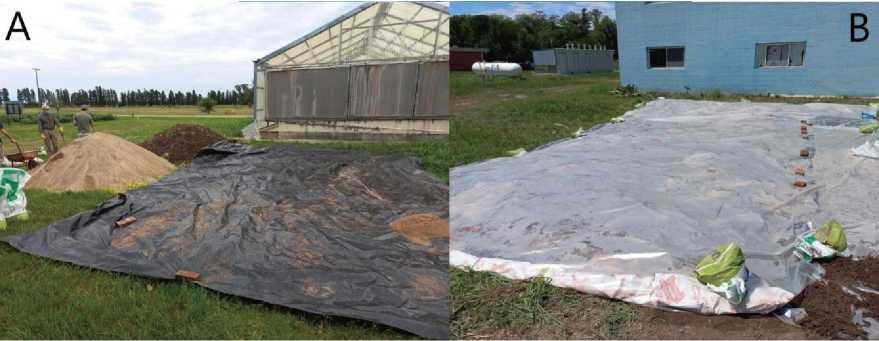
Figure 2: Assembly of the solarization system. A. Section of silo bag placed with its black side up. B. Upper covering of the solarized with polyethylene crystal
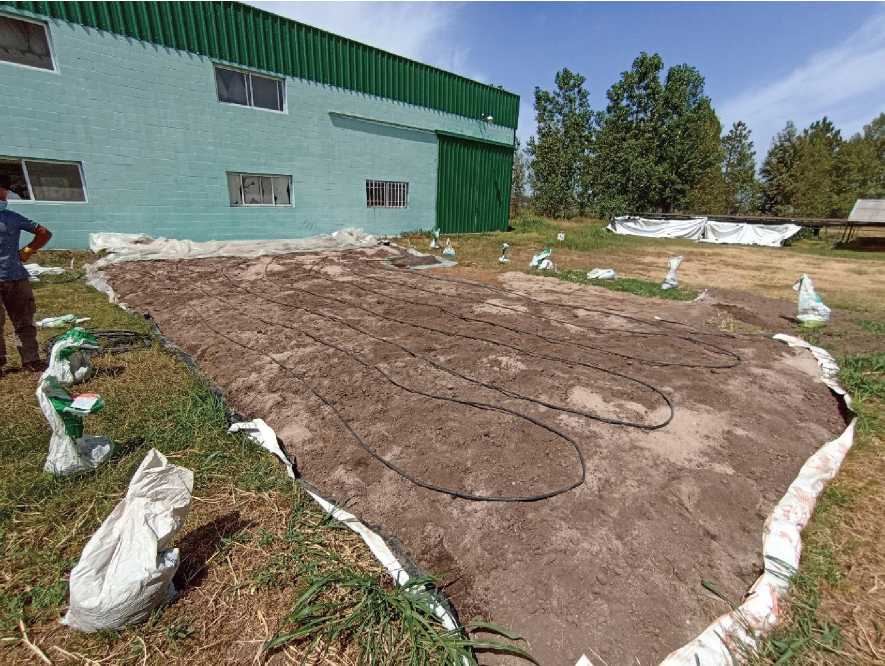
Figure 3: Drip tape installation in the solarization substrate
The solarization weed control was estimated. Fifteen pots of 3L capacity were filled with substrate before and after solarization. The pots were maintained for 30 days in a culture chamber at 25 °C at 70 % field capacity with a 12-hour photoperiod. Finally, the number of weeds was counted.
Chemical parameters
pH measurement
A substrate water suspension (1:2.5) was made by placing a fraction of the sample in water and shaking it vigorously for 5 min. The pH valué was determined in the supernatant with a multiparameter Phmeter Adwa AD1030 (Zagal and Sadzawka, 2007).
Eléctrica conductlvlty and total dissolved sollds
Electrical conductivity (EC) and total dissolved solids (TDS) were measured by the saturated paste extract technique using distilled water for soil saturation and a vacuum pump to obtain the extract (Zagal and Sadzawka, 2007; Clausi and Andreau, 2015 and Larrieu et al., 2016). EC and TDS were determined using a Hannah HI 98311 digital conductivity meter.
Statistical analysis
Data were analyzed by a one-way analysis of variance (ANAVA) followed by Fisher's LSD posteriori test (LSD; p < 0.05). The Shapiro-Wilk test was employed to determine the normality of the experimental data, and variance homogeneity assumptions were corroborated by constructing QQ-plot figures. Statistical analyses were performed using the InfoStat program (Di-Rienzo et al., 2017).
RESULTS AND DISCUSSION
During the solarization process the meteorological conditions were measured daily. The average air temperaturas ranged from 32 °C to 10 °C, while incoming solar radiation ranged from 100 W.m-2 to 410 W.m-2, with a total accumulated radiation of 50155 W.m-2 (Figure 4).
Solarization reduced the abundance of microorganisms. Solarized substrate showed the lowest values for all the parameters measured compared to the non-solarized substrate. Proteolytic (90 %), mesophiles (93 %) and fungi (100 %) were the groups that exhibited more significant reductions. The other groups like ammonifiers and nitrogen-fixing bacteria (NFB), decreased by 78 %, while yeasts and Bacillus spp., decreased by 64 and 69 %, respectively. In addition, nitrifiers decreased by 81 %, and cellulolytic by 54 %, in comparison to the non-solarized substrate (Table 1). It should be taken into consideration that the differences were statistically significant in all the functional groups analyzed. Soil solarization was found to be highly effective in reducing the population of the microbial groups analyzed in this work. Decrease in the microbial population has also been reported in several studies (Sharma and Sharma, 2002; Simmons et al., 2014 and Jiménez Rodríguez, 2019). Sharma and Sharma (2002) reported that a temperature of 40 °C under a 25 pm-thick mulch showed a lethal effect on the bacterial, fungal, and actinomycetes population under irrigated soil conditions.
This study agrees with results recorded in other greenhouse triáis, where fungi were one of the most affected groups in the solarized substrate (Jiménez Rodríguez, 2019). The author reported a reduction of oomycetes to analytical zero in a solarized substrate. Marín-Guirao et al. (2019) determined a 78 % decrease of Aspergillus spp. and 100 % of Alternaria spp. and Fusarium spp in solarization triáis. Other studies performed on solarized substrates showed a 69.57 % and 75 % decline in the abundance of Fusarium solani and Fusarium oxysporum, respectively, after 30 days of solarization (Dwivedi and Dwivedi, 2020). In addition, trials conducted on onion seedlings detected a 62 % reduction in the number of sclerotia per 100 g of the soil produced by Sclerotium cepivorum (Arbol eya and Maeso, 2018). The results obtained in the present study reveal that the bacterial groups analyzed were significantly reduced (ranging from 54 % to 100 %) when compared with non-solarized soil. Jiménez Rodríguez (2019) reports a 60 % reduction of bacterial CFU regarding the control on a substrate subjected to 72 days of solarization. After 22 days of solarization, Simmons et al. (2014) found a 66 % reduction for Rubrobacter and 100 % for Flexibacter flexilis, Aeromicrobium marinum, Flavobacterium gelidilacus and Cellvibrio japonicus species. Besides, these authors detected the increase of some species like Bacillus thermoamylovorans, a thermophilic bacterium with an optimum growth temperature of 50 °C. Other authors conducted triáis in a greenhouse with tomatoes in Italy and evaluated the effects of Pseudomonas fluorescens as a phytopathogen, reporting a 90 % decrease in disease incidence after solarization
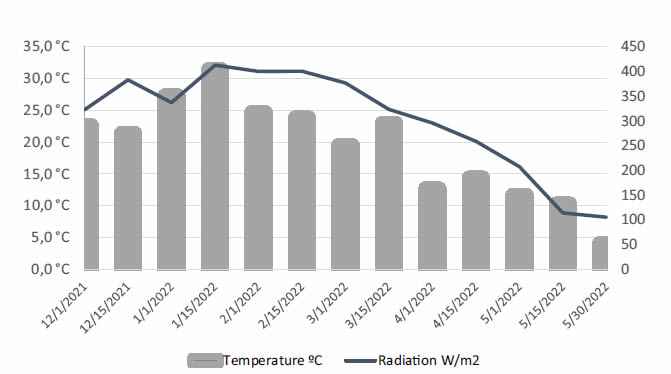
Figure 4: Meteorological data obtained from the station located at the AES INTA Manfredi during the months of the trial. Radiation: W.m-2. Average temperature: °C

Table 1: Biological parameters of the substrate before and after the solarization prooess
In the solarization process, direct and indirect mechanisms explain the decrease in the number of microorganisms. Within the direct ones, we can name death by high temperatures or inactivation by sublethal temperatures. While the reduction by indirect mechanisms is due to the subsequent colonization of the solarized substrate by antagonistic microorganisms such as thermophiles or thermotolerant ones, including Bacillus spp, Pasteuria penetrans and Trichoderma harzianum (McGovern and McSorley, 2018).
The solarization process had a significant reduction in the weed substrate pressure. The number of weeds was reduced by 99 % regarding the non-solarized substrate. The weed count before solarization showed an equivalent average valué of 394 weeds.m-2. At the end of the solarization process, only one dicotyledonous weed seedling was observed in one of the pots. A research study carried out in Santiago del Estero (Argentina) reported a 90 % reduction of weeds in four substrates subjected to solarization for 50 days (Parra et al., 2015). In addition, in other research in southern Uruguay, weed reduction/m2 was 98-99 % in solarized treatments (Arboleya et al., 2018). Gilí et al., (2017) also report reductions of 98 % of weeds after solarization in India. These findings agree with our work which points at a 99 % weed reduction.
The pH showed a decrease of 1.9 % for the solarized treatment. EC increases 5.91 % with respect to the solarized substrate. The TDS parameter was a 169 % higher in the solarized substrate compared to the non-solarized (Table 2). It has been reported, that the increase of soil temperature during solarization generates an increase in the content of soluble nutrients, dissolved organic matter, inorganic nitrogen forms (NH4+, NO3-), and some cations (K, Mg, Ca, Na), correlated with the values measured in this work (Chen and Jatan, 1982; Ghini, 1997; Chellemi and Mirusso, 2006; D'Addabbo et al., 2010; Simmons et al., 2016).
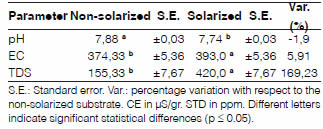
Table 2: Chemical parameters of the substrate before and after the solarization process
The relative reduction (81 %) of nitrifying microorganisms promotes the accumulation of soluble ammoniacal nitrogen (D'Addabbo et al., 2010). All these changes explain the changes in pH and TDS, and also ¡nfluence the variation of electrical conductivity, which is related to the release of high amounts of ions due to the decomposition and mineralization of organic matter (Gilí et al., 2017).
CONCLUSIONS
The implementation of solarization in greenhouse production is possible and necessary. Solarization reduced the abundance of fungal and bacterial species ¡n the substrates, it also made ¡t possible to reduce weed pressure. This research showed the ¡mportance of using this technique to disinfect the substrate before planting, thus reducing the use of chemical inputs.
Fecha de recepción: 21/02/2023
fecha de aceptación: 06/05/2023
REFERENCES
Abril, A. (2003). ¿Son los microorganismos edáficos buenos indicadores de impacto productivo en los ecosistemas? Ecología Austral, 13, 195-204, http:// www.scielo.org.ar/pdf/ecoaus/v13n2/v13n2a08.pdf
Abril, A., Noe, L., and Merlo, C. (2010). Grupos metabólicos microbianos de la laguna Mar Chiquita (Córdoba, Argentina) y su implicancia en el ciclado de nutrientes. Ecología Austral, 20(1), 81-88. https://ojs. ecologiaaustral.com.ar/index.php/Ecologia Austral/article/view/1329
Al-Shammary, A. A., G., Kouzani, A., Gyasi-Agyei, Y., Gates, W., and Rodrigo-Comino, J. (2020). Effects of solarisation on soil thermal-physical properties under different soil treatments: A review. Geoderma, 363, 114137. https://doi.org/10.1016/j.geoderma.2019.114137
Al-Shammary, A. A. G., Kouzani, A., Kaynak, A., Khoo, S. Y., and Norton, M. (2017). Experimental investigation of thermo-physical properties of soil using solarisation technology. American Journal of Applied Sciences, 14(7), 649-661. https://doi.org/10.3844/ajassp.2017.649.661
Arboleya, J., Campelo, E., and Rodríguez, J. (2008). Solarización de canteros para almácigos. Suplemento Tecnológico INIA, 28-29. http://www.ainfo.inia.uy/digital/bitstream/item/4467/1/inia-2008-suplemento-tecnologico.pdf
Arboleya, J. and Maeso, D. (2018). Solarización para el control de enfermedades del suelo. Serie Técnica INIA, 245, 46-89. http://www.inia.uy/publicaciones/ documentos%20compartidos/st-245-2018.pdf
Arboleya, J., Maeso, D., and Falero, M. (2018). Efecto del espesor del polietileno en el control de malezas con la solarización. Serie Técnica INIA, 245, 20-29. http://www.ainfo.inia.uy/digital/bitstream/item/11248/1/st-245-2018.-p.11-19.pdf
Azcona, J., Bartosik, R., Cardoso, L., Casini, C., Couretot, A., Desimone, M., Ferrari, H., Godoy, A. I., Hidalgo, R., Luque, R., Pozzolo, O., Rodríguez, J. C., Guiñazú, H. R., Santa, D. M., and Valdéz, D. (2009). in Casini, C., Rodríguez, J.C and Bartosik, R. (Eds.) Almacenamiento de granos en bolsas plásticas. INTA EEA Manfredi. https://plasticoscarmen.com/ wp-content/uploads/2018/10/esp almacenamiento bolsasplasticas.pdf
Bernal, R. (2008). Solarización: una alternativa al uso de bromuro de metilo. Suplemento Tecnológico INIA, 30-33. http://www.ainfo.inia.uy/digital/bitstream/ item/4468/1/inia-2008-suplemento-tecnologico.pdf Bettiol, W., Rivera, M. C., Mondino, P., Montealegre, J. R., and Colmenarez, Y. (2014). Control biológico de enfermedades de plantas en América Latina y el Caribe. http://www.ainfo.inia.uy/digital/bitstream/ item/14783/1/Control-Biologico-de-enfermedades-de-plantas-en-Uruguy.cap.17.2014.pdf Chellemi, D. O. and Mirusso, J. (2006). Optimizing soil disinfestation procedures for fresh market tomato and pepper production. Plant Disease, 90(5), 668-674. https://doi.org/10.1094/PD-90-0668 Chen, Y. and Jatan, J. (1982). Effect of solar heating of soils by transparent polyethylene mulching on their chemical properties. Soil Science, 130(5), 271-277. https://agris.fao.org/agris-search/search. do?recordlD=US8100278
Clausi, M. and Andreau, E. (2015). Comparación de metodologías de medición de conductividad eléctrica en pasta y extracto de saturación. Universidad Nacional de La Plata. http://sedici.unlp.edu.ar/ handle/10915/68162
D'Addabbo, T., Miccolis, V., Basile, M., and Candido, V. (2010). Soil solarization and sustainable agriculture. in Lichtfouse, E. (Eds.) Sociology, Organic Farming, Climate Change and Soil Science. Sustainable Agriculture Reviews, 3 (217-274). https://doi.org/10.1007/978-90-481-3333-8 9 Di-Rienzo, J. A., Casanoves, F., Balzarini, M. G., Gonzalez, L., Tablada, M., and Robledo, W. (2017). InfoStat versión 2017 (No. 2017). Grupo InfoStat, FCA Universidad Nacional de Córdoba. https://www. infostat.com.ar/
Díaz, M. A., Del Pilar Barrio, M., Darre, M., López, M., Cofre, M., Condori, M. S., Lazarte, D., Trevisán, V., Peirano, C., Del Bo, C., Cañete, A. L., and Alcaide, M. (2014). Análisis microbiológico de los alimentos: Microorganismos indicadores (3rd ed.). Trinks ANMAT. Dwivedi, N. and Dwivedi, S. K. (2020). Soil solarization: An ecofriendly technique to eradicate soil fusaria causing wilt disease in Guava (Psidium Guajava). International Journal of Fruit Science, 20(3), S1765-S1772. https:// doi.org/10.1080/15538362.2020.1833808 Ghini, R. (1997). Desinfestagao do solo com o uso de energía solar: solarizagao e coletor solar. Circular Técnica 1. Centro Nacional de Pesquisa de Monitoramento e Avaliagao de impacto Ambiental. Jaguariúna, S P. https://www.infoteca.cnptia.embrapa. br/infoteca/handle/doc/895433 Gill, H. K., Aujla, I. S., De Bellis, L., and Luvisi, A. (2017). The role of soil solarization in India: How an unnoticed practice could support pest control. Frontiers in Plant Science, 8. https://doi.org/10.3389/fpls.2017.01515
Jiménez Rodríguez, J. D. C. (2019). Eficacia de la biodesinfección de suelos de invernadero de Almería sobre la microbiota edáfica, en función de las fechas y tiempos de aplicación. Universidad de Almería. http:// hdl.handle.net/10835/8174
Katan, J., DeVay, J. E., and Greenberger, A. (1989). The biological control induced by soil solarization. In Tjamos, E. C., Beckman, C. H. (Eds.) Vascular wilt diseases of plants (493-499). Springer Berlín Heidelberg. https://doi.org/10.1007/978-3-642-73166-2 37
Lanfranco, J. W., Pellegrini, A., and Cattani, V. M. (2014). Contenidos de edafología. Génesis, evolución y propiedades físico químicas del suelo. EDULP. https:// doi.org/10.35537/10915/37325 Larrieu, L., Clausi, M., Bongiorno, F., Merani, V., Nughes, L., Juan, L., Mainero, J., Bernardi, D., and Millán, G. (27 de junio al 1 de julio de 2016). Conductividad eléctrica en pasta y extracto modificando tiempos de reposo en suelos de regiones húmedas. In Cholaky C. G., Cisneros, J. M. (Comps.) XXV Congreso Argentino de la Ciencia del Suelo. Ordenamiento territorial: Un desafío para la Ciencia del Suelo. Universidad Nacional de Río Cuarto. Río Cuarto, Córdoba, Argentina: UniRío. http://www.unirioeditora.com.ar/producto/xxv-congreso-argentino-la-ciencia-del-suelo/
Lenscak, M. P. and Iglesias, N. (2019). Invernaderos: tecnología apropiada en las regiones productivas del territorio nacional argentino (del paralelo 23 al 54), 1-226. INTA . https://bibliotecavirtualtodoeduca. com/wp-content/uploads/2021/12/Invernaderos.-Tecnologia-apropiada-en-las-regiones-productivas-del-territorio-nacional-argentino-1.pdf Marín-Guirao, J. I., de Cara-García, M., and Tello-Marquina, J. C. (2019). Efecto de la desinfección de suelos sobre las comunidades fúngicas edáficas asociadas a cultivos hortícolas. Ecosistemas, 28(3), 63-72. https://doi.org/10.7818/EC0S.1708 McGovern, R. J. and McSorley, R. (2018). Physical methods of soil sterilization for disease management including soil solarization. In Rechcigl, J. E. (Ed.) Environmentally Safe Approaches to Crop Disease Control (283-314). CRC Press. https://doi. org/10.1201/9781351071826-17 Merlo, C., Abril, A., Amé, M. V., Argüello, G. A., Carreras, H. A., Chiappero, M. S., Hued, A. C., Wannaz, E., Galanti, L. N., Monferrán, M. V., González, C. M., and Solís, V. M. (2011). Integral assessment of pollution in the Suquía River (Córdoba, Argentina) as a contribution tolotic ecosystem restoration programs. Science of The Total Environment, 409(23), 5034-5045. https://doi. org/10.1016/j.scitotenv.2011.08.037 Parra, M. V., Sobrero, M. T., and Pece, M. G. (2015). Solarización: Una alternativa de control de malezas para viveristas. Foresta Veracruzana, 17(1), 9-16. https://www.redalyc.org/journal/497/49742125002/html/
Rocha, F. Y. O., Oliveira, C. M. de, da Silva, P. R. A., Melo, L. H. V. de, Carmo, M. G. F do, and Baldani, J. I. (2017). Taxonomical and functional characterization of Bacillus strains isolated from tomato plants and their biocontrol activity against races 1, 2 and 3 of Fusarium oxysporum f. sp. Lycopersici. Applied Soil Ecology, 120, 8-19. https://doi.org/10.1016/j.apsoil.2017.07.025
Sharma, M. and Sharma, S. K. (2002). Effect of soil solarization on soil microflora with special reference to Dematophora necatrix in apple nurseries. Indian Phytopathology, 55, 158-162. https://epubs.icar.org. in/index.php/IPPJ/article/view/18688 Simmons, C. W., Claypool, J. T., Marshall, M. N., Jabusch, L. K., Reddy, A. P., Simmons, B. A., Singer, S. W., Stapleton, J. J., and VanderGheynst, J. S. (2014). Characterization of bacterial communities in solarized soil amended with lignocellulosic organic matter. Applied Soil Ecology, 73, 97-104. https://doi. org/10.1016/j.apsoil.2013.08.014 Simmons, C. W., Higgins, B., Staley, S., Joh, L. D., Simmons, B. A., Singer, S. W., Stapleton, J. J., and VanderGheynst, J. S. (2016). The role of organic matter amendment level on soil heating, organic acid accumulation, and development of bacterial communities in solarized soil. Applied Soil Ecology, 106, 37-46. https://doi.org/10.1016/j. apsoil.2016.04.018
Vuelta Lorenzo, D. R. (2014). La biofumigación y la solarización como alternativas al manejo de plagas del suelo. Ciencia en su PC, 1, 15-26. https://www. redalyc.org/articulo.oa?id=181331235002 Wang, Y. P, Li, X. G., Fu, T., Wang, L., Turner, N. C., Siddique, K. H. M., and Li, F.-M. (2016). Multi-site assessment of the effects of plastic-film mulch on the soil organic carbon balance in semiarid areas of China. Agricultural and Forest Meteorology, 228-229, 42-51. https://doi.org/10.1016/j.agrformet.2016.06.016 Zagal, E. and Sadzawka, A. (2007). Protocolo de métodos de análisis para suelos y lodos. Santiago, Chile. https://hdl.handle.net/20.500.14001/30754